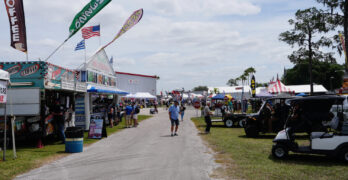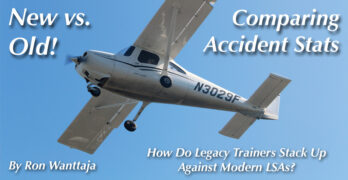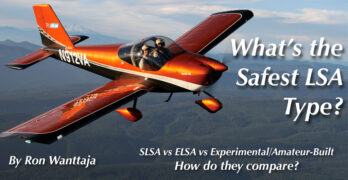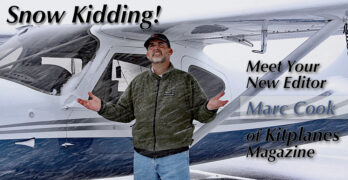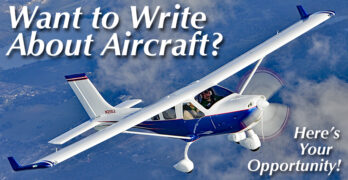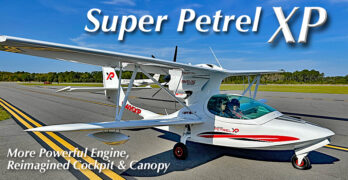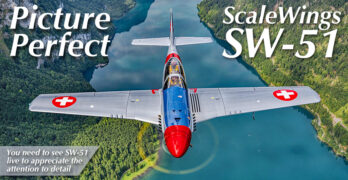It’s delightfully warm and getting even better here in Lakeland, Florida, for the 50th running of the Sun ‘n Fun. What’s happening? Lots. Why haven’t you read much of it here yet? Good question.
Truth is, I was stuck on the Experimental side of the situation—not a bad place to be, actually—for the first day of the show. But that doesn’t mean there isn’t news to report. Junkers unveiled its new radial-engined A50 today. I spent some time with Dynon Avionics to talk about the new 12-inch version of the SkyView HDX. (See the video I did for Kitplanes below.) And there’s much more to come, with an important opening reception tonight centered on the LSA market. Plus a few of the hardy souls who reached out with an interest to write for this site have been turning in their fine words.
Sun ‘n Fun, from a working perspective, is a whirlwind.
Search Results for :
Not finding exactly what you expected? Try our advanced search option.
Select a manufacturer to go straight to all our content about that manufacturer.
Select an aircraft model to go straight to all our content about that model.
Junkers Goes ‘Round — The Scarlett 7U Radial A50 Heritage Is Here!
Editor’s Note: This is a quick preview of the new A50 from Junkers we thought you should hear about ASAP. After we catch our breath, we’ll try to update the story with more detail on such things as pricing and availability. In the mean time, welcome Amy Wilder, editor of our sister publication Plane & Pilot, who is helping out here at Sun ‘n Fun.
Last year at Sun ‘n Fun, Junkers Aircraft Corp. unveiled its A50 Junior design, a revitalized take on the classic 1929 design by Hermann Pohlmann. The refresh featured the classic design, with a Rotax 912 engine.
Based on consumer feedback and requests, the company today unveiled its A50 “Heritage” model, which the company said in a release “meticulously captured the essence of Hugo Junkers’ imaginative and original design” with its Scarlett 7U radial engine and two-piece glass windscreen.
Stay tuned for a video of the press event from this morning’s unveiling at the expo.
Light Sport Accidents — New LSAs vs. Legacy Trainers
Editor’s Note: This is the second part of Ron Wanttaja’s survey of LSA safety (here’s the first). This time, he takes a close look at how modern LSAs compare with legacy trainers as epitomized by Cessna’s 152, both in terms of accident rates and the kinds of mayhem they succumb to. Let’s dive in!
In the previous safety review, we looked various forms of LSA—SLSA, ELSA and Experimental/Amateur-Built. For this article, we’ll look only at SLSA airplanes. We’re not addressing powered parachutes, weight shift or other SLSA classes—just traditional flying machines with wings and a motor. Call them “SLSA-A,” or “SLSA-As” for plural. We’ll address their accidents from 2005 through 2021.
To identify the SLSA-A accidents, I cross-referenced the NTSB accident database with FAA registrations, including both active and inactive aircraft.
What to compare them to? Let’s pick the near-ubiquitous Cessna 152. It’s close to the general definition of Light Sport, other than exceeding the LSA gross weight requirement.
Swedish LN-3 Seagull — Tandem-Seating LSA Seaplane …Plus, Breaking News!
LSA seaplanes are a segment all to themselves. [See Breaking News at bottom!]
It isn’t only that seaplanes can offer “triphibian” capabilities (a term once promoted by MVP) because they can operate from land, water, or snow. That makes them versatile but amphibious craft must incorporate retractable gear and since they require a sturdy hydrodynamic boat hull as well as aerodynamic aircraft structures, the engineering task becomes significantly larger than land plane designs.
Icon took years with their A5 and Vickers is still working on their Wave. Both took more than a decade to reach market. Several other LSA seaplane projects required similarly lengthy development.
Now from Svenska Flygfabriken (Swedish Aviation Factory) comes LN-3. This new entry is distinctive because it is a tandem-seating seaplane. Yes, I know lots of Cub-types on floats are tandem but among boat-hulled seaplanes, I’m not aware of any others like this.
Light Sport Accidents — How Do The Categories Compare?
Editor’s Note: This two-part short series is the handiwork of Ron Wanttaja, who has been tracking accident and registration data for Experimental aircraft for decades. Here, he looks at both the fleet size and accident rates among the various LSA categories. Looking ahead, the next installment will dig deep into how LSAs fare against more common certified trainers.
It’s been almost 20 years since the FAA implemented the Light Sport Aircraft category. While the planes might appear similar to traditional Experimental/Amateur-Built (E/A-B) aircraft, there are significant differences in how they are designed, constructed, maintained and operated.
Light Sports have had a major impact on flying in the U.S., even if their numbers are still relatively few. Without Light Sport (and the accompanying Sport Pilot program), the FAA would have lacked data to justify the simplification of pilot medicals known as BasicMed. Light Sport’s proven safety led to the MOSAIC program, featuring a major relaxation of the limits of what can be flown without an FAA medical.
Who Is This Guy, Anyway? Please Welcome, Marc Cook!
You’re probably wondering about this raspy old voice appearing on the ByDanJohnson site. Who are you and what have you done with Dan? Part of that you already know.
Dan sold this site to what was then the Flying Media Group, owned by Craig Fuller, an LSA owner himself. Since adding a bunch of marine titles from Bonnier, the overarching company is now known as Firecrown, but the aviation side is still a big part of the portfolio, including FLYING, Plane & Pilot and KITPLANES (among many others). ByDanJohnson, when it becomes Affordable Aviation, will fit like the perfect puzzle piece into the group
Speaking of KITPLANES, that’s where I come from. In fact, Dan and I have history—the good kind—as he wrote about the then-nascent LSA category for KP back when all this got started. We felt it was important to get smart about the segment since it would intersect with Experimental aircraft.
Good Neighbor! — How Sling Pilot Academy Made Their Trainer Whisper
Harley Davidson or Rotax — Sounds can be unique and associated with a certain brand. Harley motorcycles have made their sound a trademark, defending it vigorously against wannabe knock-offs.
Sling Pilot Academy found Rotax 912iS engines output a particular sound, too. However, they wanted to shield their neighbors from it. As busy as Sling Pilot Academy has become, keeping good relations is essential.
So, Whisper Sling
Necessity is the mother of invention, so the saying goes. Necessity, in this case, was success.
(SPA) at the Torrance, California, airport has grown to become a training behemoth, with their fleet flying more than 4,000 hours per month, the bulk of it in the Sling two-place LSA it uses as a primary trainer. That makes the SPA one of the busiest training companies in the region.
And Torrance, like many urban airports, faces increasing complaints from non-pilot neighbors; in fact, Torrance’s very existence has been threatened for decades by those opposed to the presence of airplanes at, get this, an airport.
Do You Love LSA and Sport Pilot Kits? Calling for Writers in the Affordable Space
By the middle of March, this website had exceeded all prior monthly records. In only 16 days, we recorded an all-time high in single-day non-repeating visitor count and in monthly visitors.
So, it is already certain that I will conclude my full-time activities with ByDanJohnson.com on a very high note and I am grateful beyond what I can convey. I had hoped to “go out at the top of my game” and this strong response from visitors is a wonderful send-off.
Please believe me, though, the genuine thanks are from me to you, not the other way around.
I am deeply appreciative of your loyal readership for these past 20 years. Thank you from the bottom of my pilot’s heart.
Is Affordable Aviation
Really a Thing?
I didn’t know I was creating the affordable aviation space when I began my online adventure back in 1999 — it took four years of work in those early days of the World Wide Web but we went live on April 1, 2004.
Super Petrel XP Arrives in Florida; Proven Product Significantly Upgraded
A few days ago a couple Super Petrel XPs arrived in Florida. In no time, Roger Helton‘s team had the pair assembled and had earned their Special Airworthiness Certificates, from two different FAA inspectors no less.
Development happens fast in light aviation; Mosaic will further quicken the pace.
Welcome to Light-Sport Aircraft where the swift thrive and those that can’t move fast enough fall behind. LSA is a market full of seasoned competitors. They’ve learned their trade well, surviving and some even gaining during the Covid upset. Any new creation coming to market will be measured against tough standards.
You think the pace of development is fast now? Wait as Mosaic approaches and company after company announces new products to take advantage of the “Christmas in July” list of new privileges FAA offered in the summer release of their Mosaic proposal (view list at bottom). The regulation is currently in review by the agency and according to their own statements, it should go live by second quarter 2025 (2Q25).
Your Own P-51? (Only Modern?) — Remarkable SW-51 Increases Production
Every pilot loves a P-51 Mustang, right? The World War II fighter with gutsy lines and a thundering engine turning a giant prop consistently ranks as one of the most desirable airplanes of all time.
Don’t even think about affording a real P-51 unless you win the lottery. Warbirds may be the biggest attraction at AirVenture Oshkosh year after year but only a few pilots have sufficiently deep pockets to own and fly one of these historic machines.
SW-51 is breathtakingly priced as well, many readers may think. Nonetheless, SW-51 is an awesome-looking flying machine that some will figure out how to afford.
Even more rare than a Ferrari, SW-51 is a very-limited-production design. The company forecasts a dozen aircraft per year. At that rate and given SW-51’s exquisite detail, I’ll bet they can sell out year after year.
Mount Your Mustang
You can watch a video below from Sun ‘n Fun 2022 that provides additional and fairly recent detail.


